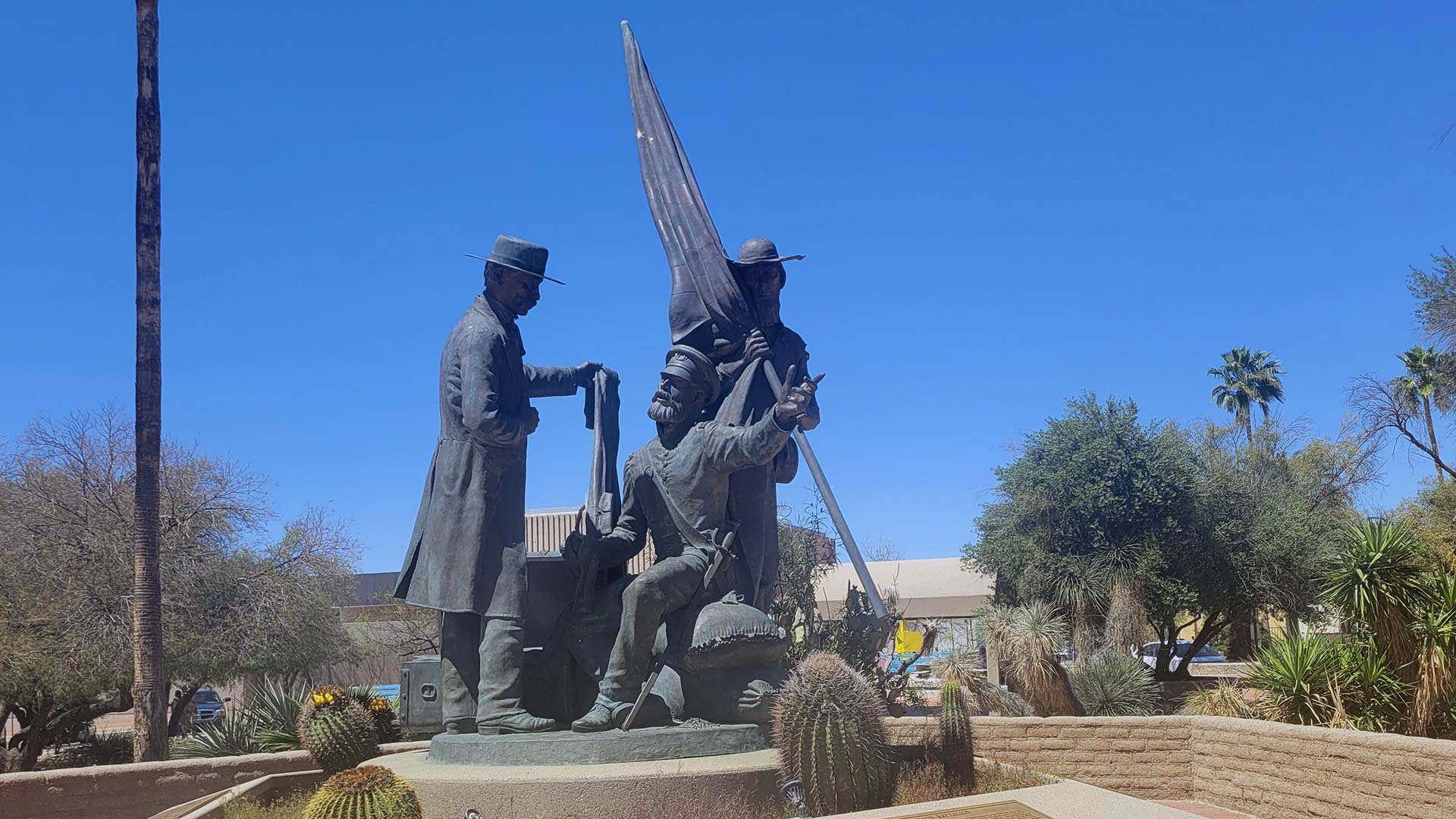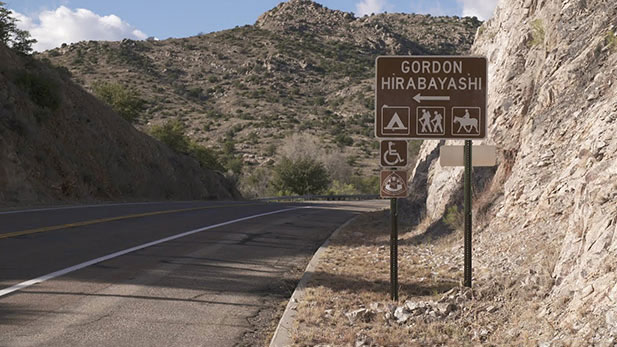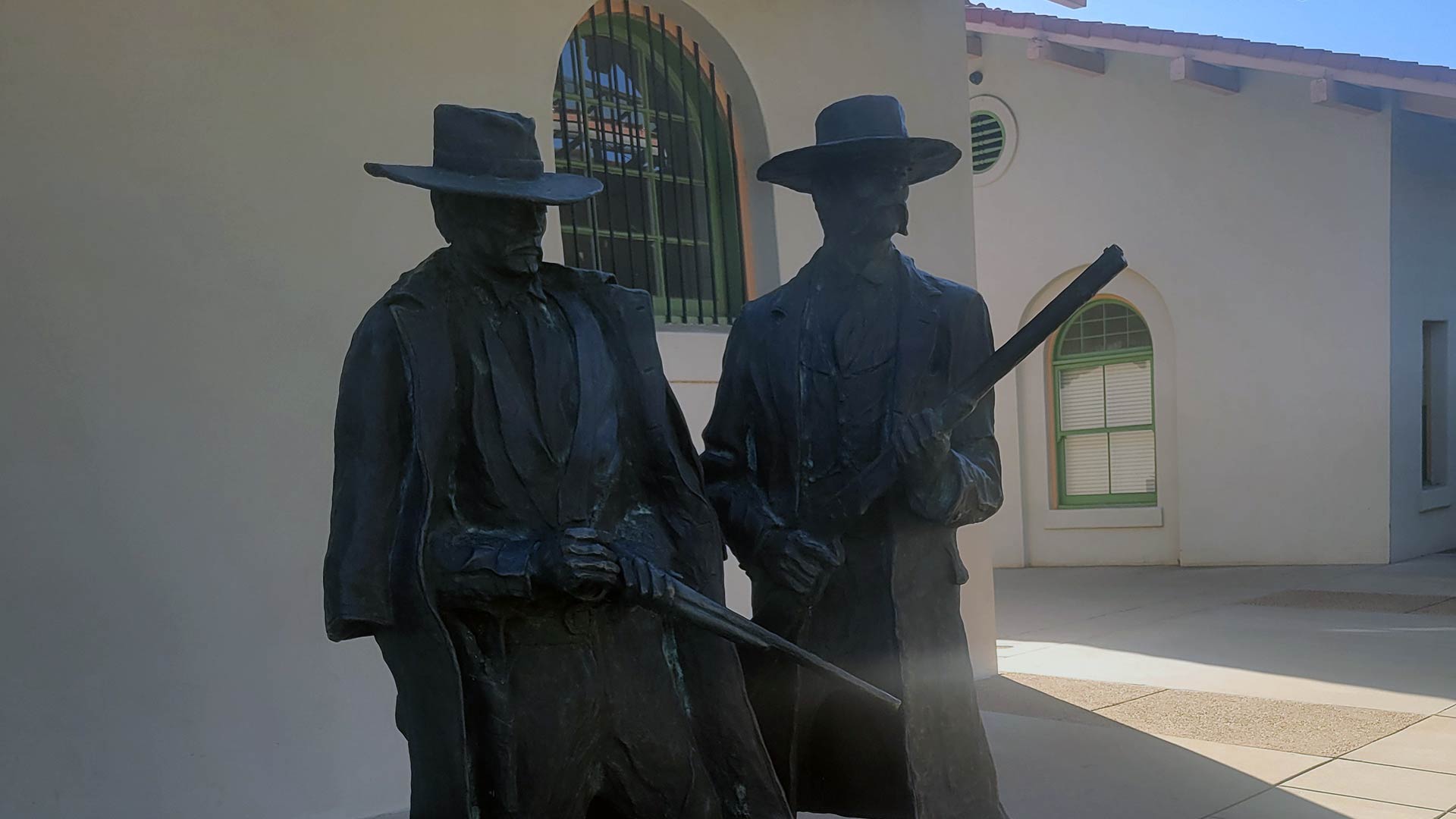 The Mormon Battalion historic marker on Alameda Street in downtown Tucson.
The Mormon Battalion historic marker on Alameda Street in downtown Tucson.
The Buzz for April 19, 2024

Arizona's NPR member stations have spent the week stopping by the side of the road to take a closer look at some of Arizona's most notable highway markers. Our On the Road in Arizona series has given attention to a handful of those spots and the historic significance they hold.
One group that is frequently mentioned on such markers across Southern Arizona is the Mormon Battalion.
The only religiously segregated military unit in U.S. history is commemorated on at least 13 markers spread across the portion of their 2,000 mile march that went through what was then the Arizona Territory.
"[The march] was all taking place during a war," said The Mormon Battalion Foundation's Richard Burton. "The Mexican American War that was started in 1846, declared by President Polk, and it was a dispute of land in Texas that accelerated into war. Lieutenant Colonel Kearney began his march to the west and needed more recruits. So he went to a contingent of Latter Day Saints Church of Jesus Christ of Latter Day Saints who are camped along the Missouri River, having been driven out of Nauvoo, Illinois, their city, by persecution and mobs."
Brigham Young, who was then the LDS church's prophet, was trying to relocate members of the faith to the area around Utah's Great Salt Lake. Working with the Army would not only relocate the 500 people who volunteered, but it would also provide funding to move other church members westward.
"They were marching across uncharted areas. It became, at least in the history we can find, the longest United States Infantry march in history.It was a very strenuous time, and, in fact, they started with 500, and by the time they got to San Diego, there are only 350 with sick detachments being deployed to Pueblo, Colorado."
Along the journey, the battalion mapped a path that would later be used as a wagon trail, followed by rail lines and interstate highways. The group was also notable for their lack of violent interactions with native people and Mexican inhabitants. Troops were said to have only opened fire twice through the march.
One time was an interaction with a group of cattle who had gone feral after escaping from a ranch, and the other was during their time in a presidio that was located in what is now downtown Tucson.
"The battalion came in, did their trading, raised the first American flag in the Tucson area, and then camped for the night," said Burton. "And they put out, as they would, their pickets. And whether it was coyotes or someone else, somebody approached the pickets. So they fired the rifles and then retreated to the main contingent."
"But knowing that there was a Mexican garrison was a militia of local denizens here," said the foundation's Randy Madsen. "And when they heard that the battalion was coming, about 350 men, they decided to relocate to San Xavier Del Bac mission for a few days and the battalion was going to actually go out and encounter them. However, they were afraid of an ambush, so they just retreated back and nothing happened."
The group was also part of the discovery of gold in mountains in southern California, playing a minor part in the upcoming gold rush.
Burton and Madsen say the voyage was about economic benefit and building a path for American settlement of the west. The land they mapped would later become a part of the United State through the Treaty of Guadalupe Hidalgo in 1848 and later the Gadsden Purchase of 1853.
They point to a letter sent by Lieutenant Colonel Philip St. George Cook to the governor of Sonora
"Be assured I did not come as an enemy of the people whom you govern, they have received only kindness from my hand," Burton quoted. "Meanwhile, I make a wagon road from the streams of the Atlantic to the Pacific Ocean, through the valuable plains and mountains of Sonora. This I trust will prove useful to the citizens of either Republic, who, if not more closely, may unite in the pursuit of a highly beneficial commerce."
Decades later, after Arizona had become a state and Tucson had established itself, another event took place to the city's northeast, about 2,000 feet in elevation up. The Catalina Federal Honor Camp was established with the mission of creating a new road up Mount Lemmon so that Tucsonans could escape the summer heat or enjoy mountaintop snow in the winter.
"This was at a time in the country when there was a good roads movement when people wanted better roads, more people were getting automobiles of different types," said Dr. Cherstin Lyon, an historian who wrote the book Prisons and Patriots: Japanese American Wartime Citizenship, Civil Disobedience and Historical Memory. "And so it was was a great marriage between a movement to create better roads, a need for an easier way to get up the mountain. And then also this movement in thinking about prisons, that prisons should provide opportunities for rehabilitation, should provide job training."
The prison was originally populated with people who had committed lower-level federal crimes such as tax evasion, immigration law violations or selling alcohol to Native Americans, she said. But World War II brought in new varieties of prisoners, including conscientious objectors to the draft and those who felt obligatory military service was a violation of their rights.
"Japanese Americans who were drafted into the military without the right to leave the War Relocation Authority camps and go back home. They didn't have free, full citizenship. And yet they were being drafted into the military. And so some used it as a personal case of resistance. And some people wanted to make it into a test case because they thought this can't be right. We can't have only some rights of citizenship, meaning the right to die for our country and not have the right to maybe go back home and farm and have an agricultural deferment for the war."
That led to the man who would become the camp's most well-known prisoner. Gordon Hirabayashi found his way to the camp after he lost his appeal to the U.S. Supreme Court in a case involving his refusal to follow laws that both imposed a curfew on Americans of Japanese ancestry and later relocated them to federal detention camps.
 A road sign marking the Gordon Hirabayashi campground.
A road sign marking the Gordon Hirabayashi campground."[Hirabayashi] said, 'I don't want to do it in a walled institution. I don't want to do it in some county jail in Seattle. I want to be outside,'" said Lyon. "And the judge said, 'there aren't any prison camps that are anywhere near here that we can get you to.' The only one that the judge knew of was down in Tucson, Arizona. And Gordon Hirabayashi said, 'I'll get myself there if I can go there.' And he said, Sure. So it's a great story about Gordon Hirabayashi hitchhiking all the way down to Tucson."
For Hirabayashi and others, the camp was a welcome change from the conditions that others were being held in, with some likening it to summer camp in comparison.
"The people who were Japanese Americans, other than Gordon Hirabayashi, who ended up in the camp above Tucson came from Topaz, Utah and Ammachi, Colorado. Two pretty remote, desert environments where relocation authority camps where the dust was bad, where the food was pretty bad, where they couldn't leave, they were guarded by, you know, men in search towers with rifles. And those were the individuals who, when they talked about it later said, the food was good. There weren't any fences, there were just rocks painted to show us where the border of the camp was."
Heading back into downtown and into the area's territorial history, a statue near Tucson's train station marks the spot where one of the final acts in a legendary Old West feud happened.
 The statue of Doc Holliday and Wyatt Earp near the train station in downtown Tucson.
The statue of Doc Holliday and Wyatt Earp near the train station in downtown Tucson.
The statue shows Wyatt Earp and Doc Holliday holding a rifle and a shotgun, and sits in the spot where they shot Frank Stilwell, a member of the group they faced off against at the O.K. Corral.
"Most eyewitnesses say that Stilwell was here, elements of The Cowboys were here, the Earps were here, violence occurs, Stilwell is killed and the Earps left town. That's kind of the long and the short of the story," said Jaynie Adams, an historian with the Arizona Historical Society. "There's all kinds of different nuances because there's all different eyewitness perspectives from this. Some people say that Stilwell and The Cowboys were kind of laying in wait for the Earps. Some people say that Stilwell and his accomplices were actually trying to do right and headed to a court hearing for a previous crime that they may or may not have committed. Other folks say the Earps were here waiting for Stilwell and it was an ambush. So it's just kind of all over the place. But the long story is this violence occurred in Tombstone, and subsequent violence that occurred here in Tucson was related to that event."
The marker is among many that note particular places where the incidents of violence from this clash took place, and among a long list where Old West shootings happened.
"There are tons of historical markers throughout the state that are dedicated to moments of violence. This is an incredibly violent time, and not only because of the violence the shoot out at the OK Corral, which is a political difference or maybe it's a dispute over land, or maybe it's a romantic dispute, whatever is happening, that distills into that violence. That kind of violence is occurring, but you also have violence associated with settler colonialism, right? So you'll see markers of certain massacres of indigenous people, for example, or violence the other way indigenous people enacting violence on settlers. So to say that the Earps story is particularly juicy, I think is fair, especially because Wyatt enlisted a friend of his who was not only a journalist but a screenwriter to assist in producing his biography/autobiography, whatever you want to call it, and adding a little bit of dramatic flair that maybe necessarily wasn't there. But it does make for good television."
Adams said the mythologizing and romanticizing of the Old West and its violent tendencies say as much about modern times as it does the era itself.
"I would say that you always need to think about when something is created. So westerns are a really good example, a lot of our westerns are coming from the late 1940s into the 1950s and 1960s. That is a particular moment in time that has its own historical context. It's totally different from the historical context that it's trying to portray. So when we remember that film, art, literature are products of their own time, we need to remember that there is the context and the bias of the person."




By submitting your comments, you hereby give AZPM the right to post your comments and potentially use them in any other form of media operated by this institution.